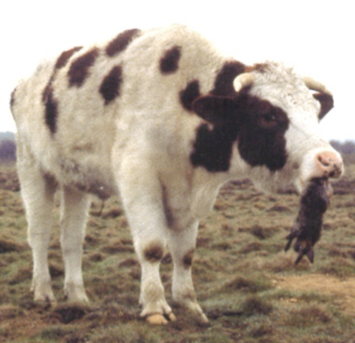 Several years ago I was looking for animal behavior information that would help me understand why some groups of cattle learned to eat weeds more quickly and easily than others. I’d noticed that the slow learners were typically more nervous, and I was strolling the stacks at the library at Colorado State University and browsing through books with potential.
Several years ago I was looking for animal behavior information that would help me understand why some groups of cattle learned to eat weeds more quickly and easily than others. I’d noticed that the slow learners were typically more nervous, and I was strolling the stacks at the library at Colorado State University and browsing through books with potential.
In one, I found an article by Alain Boissy, Claudia Terlouw, and Pierre Le Neindre “Presence of Cues from Stressed Conspecifics Increases Reactivity to Aversive Events in Cattle: Evidence for the Existence of Alarm Substances.“ (Right!) Translated into English, what the researchers had found was that when calm heifers were offered food to eat, they ate it. Then the researchers introduced a stressed heifer to the group. When she entered the pen and then peed, the animals in the pen were much slower to try the food that was offered to them. The stressed heifer didn’t eat at all. “Is there something in the urine that causes this response?” wondered the researchers.
On to step two then. The researchers collected urine from both stressed and non-stressed heifers. They sprayed this urine on pads under feed tubs. They found that the animals took much longer to try the feed in the tubs scented with urine from stressed animals. In another experiment, they also found that heifers were slower to explore an unfamiliar object in their pen when it was sprayed with urine from stressed animals.
If you are imagining this whole process in your head, it looks pretty silly. What I imagine is researchers chasing a heifer to increase her stress, then rushing around to catch her urine, loading it in spray bottles and then spritzing it around to see the results. It may look funny, but the results help us think about the ways we manage our animals. Here’s how I suggest using this information:
1. Got an animal that is always nervous? Get rid of her. She’s riling up your calm gals and reducing their food intake just by sharing her fear every time she pees.
2. Are you introducing new members to your herd? They’re likely stressed just from the move, so before you put everyone together in the same pen, give the newbies some time to acclimate to their new surroundings.
3. If I’m training cows to eat weeds, I want to be sure that I don’t do things that will cause stress that will then be communicated from animal to animal as they stand around the tubs, potentially peeing. So I stay calm and quiet, I make it a fun experience every time they show up at the tubs, and I never chase them or herd them to the tubs.
Have you got other ways you might use this information? Do share!





I try not to herd (follow) my animals, but lead them to a new paddock, to new hay in the corral, etc.
By the way, I believe my oldest cow, named Cow, thinks that a good pee helps her think things through.
(When I was on the board of an educational institution, we would have a coffee break if things were getting tense. I don’t know about the women, but the men–older men–would line up at the urinals soon after even a sip of coffee. Then small talk and some discussion of the topic took place. It worked.) Maybe cows need to have a communal pee sometimes, too.
Disposition, disposition, disposition. More and more we understand the importance of this trait. Usually we think of disposition as a cow much worse than just nervousness.
Comments are closed.